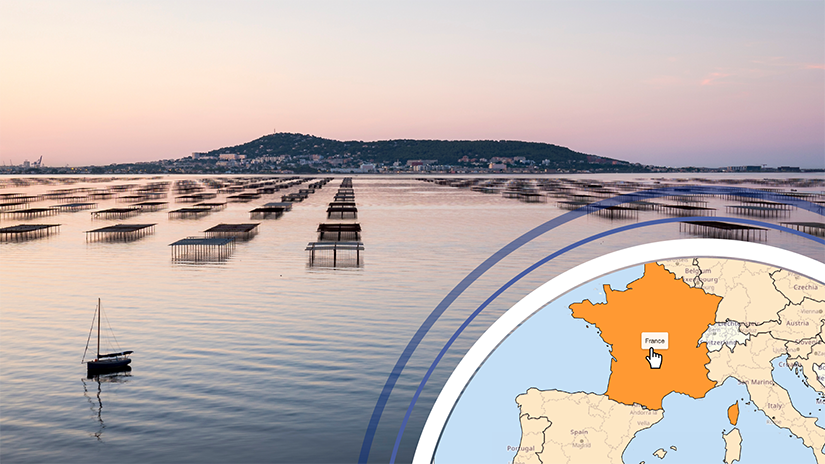Background information

Vrsta uzgojene vrste
Pacifička kamenica (Crassostrea gigas), dagnja (Mytilus edulis), kalifornijska pastrva (Oncorhynchus mykiss), rumenca okana (Sparus aurata).
Izvor podataka: 2024., STECF
Vrsta metode proizvodnje
U 2 022,80 % francuske proizvodnje odvijalo se u morskim i bočatim vodama, a 20 % u slatkoj vodi. Primijenjene su sljedeće glavne metode proizvodnje:
Izvor podataka: 2025., EUMOFA
Ostatak (5 %) uzgajan je primjenom drugih metoda za koje nisu dostupne pojedinosti.
Veličina sektora (proizvodnja i potrošnja)
Izvor podataka: 2024., EUMOFA i STECF
Trendovi (prošli i budući)
- Pojednostavnjenje administrativnih postupaka
- Prostorno planiranje
- Zdravlje i dobrobit životinja
- Okolišna učinkovitost,
- Inovacija
- Prikupljanje podataka i komunikacija,
Izvor podataka: MNSPA
Utjecaj akvakulture na gospodarstvo, tržište hrane i tržište rada zemlje
- Domaća proizvodnja vodenih proizvoda obuhvaća samo četvrtinu potrošnje.
- Francuski uzgoj školjkaša drugi je najveći uzgoj u Europi, s prosječnom proizvodnjom od 140000 tona morskih prehrambenih proizvoda. Karakterizira ga visok stupanj heterogenosti u pogledu uvjeta uzgoja, kako u pogledu vrsta (sastojke, dagnje, kućice itd.) tako i u pogledu raznolikosti proizvodnih pogona duž francuske obale.
- Francuski uzgoj ribe treći je najveći proizvođač slatkovodne pastrve u Europi. Francuska se ističe i kao jedan od vodećih svjetskih proizvođača kavijara na svijetu (s 43 tone godišnje) i kao pionir u području morskog uzgoja u Europi zahvaljujući svojem ovladavanju uzgojem ribe i hranom za ribe.
- Posljednjih godina raste sektor uzgoja morskih algi, posebno spirulina.
- Ti su sektori vrlo dinamični u pogledu istraživanja i inovacija, posebno u uzgoju ribe.
- Međutim, unatoč potencijalu tih sektora, razvoj akvakulture i dalje je ograničen. Sektori se suočavaju s nedostatkom privlačnosti, što je povezano s teškim radnim uvjetima, nedostatkom imidža među stanovništvom i niskom društvenom prihvatljivošću novih projekata.
- Francuska akvakultura doprinosi razvoju obale i ruralnih područja jer stvara radna mjesta koja se ne mogu premjestiti unutar obiteljskih poduzeća.
- Povećanje proizvodnje u akvakulturi kako bi se osigurala lokalna potrošnja i poboljšanje kvalitete akvakulture.
Izvor podataka: MNSPA
Izazovi i prilike
- Francuska akvakultura mora ispunjavati očekivanja društva i građana te održavati visoku razinu gospodarske i ekološke učinkovitosti.
- Izazovi današnjice i sutrašnjice više su povezani s daljnjim pravnim jačanjem postrojenja i provedbom plana napretka kako bi se olakšao razvoj ribogojilišta, uključujući uzgoj slatkovodnih ribnjaka.
- Taj bi se sektor trebao i dalje pozicionirati na stranim tržištima, a domaće tržište trebao bi opskrbljivati zdravim proizvodima s niskim ugljičnim otiskom i visokom dodanom vrijednošću.
- Usmjerenost na kvalitetu kavijara: Konsolidirati postojeće tržišne udjele s budućim ZOZP-om. „Kavijar d’Aquitaine”.
- Razvoj proizvodnje dimljene pastrve kako bi se osiguralo rastuće i zahtjevno nacionalno tržište.
- Uzgoj ribe u ribnjacima: preokrenuti trend podupiranjem tih ekstenzivnih poljoprivrednih gospodarstava, koja doprinose bioraznolikosti, lokalnom animiranju i opskrbi lokalnim bjelančevinama.
- Jačanje uzgoja školjkaša: nove mogućnosti razvoja, nove lokacije, novi proizvodi, nova tržišta.
- Poboljšanje slike akvakulture u smislu utjecaja na okoliš, čemu se dodaje pitanje dobrobiti životinja.
- Omogućivanje razvoja integrirane multitropske akvakulture (IMTA).
- Proizvoditi zdravu i dobro obrađenu ribu koja ispunjava zdravstvene i društvene zahtjeve, s održivim gospodarskim modelom i nusproizvodima koji se stvaraju potpuno sigurno.
- Francuska akvakultura ima velik potencijal za rast.
- Proizvodi akvakulture pridonose diversifikaciji izvora bjelančevina i nude lokalnu opskrbu s ograničenim ugljičnim otiskom.
- Mogući razvoj proizvodnje dagnji i kamenica.
- Približavanje novoj ciljnoj proizvodnji (1000 Tn do 2027.) u akvakulturnoj proizvodnji morskih algi s velikim potencijalom na tržištu. Riječ je o mladom sektoru: u njemu se kombinira uzgoj makroalgi, mikroalgi i cijanobakterija (spirulina).
- Promicanje pojedinačnih i kolektivnih mjera pojačanog opreza kako bi se očuvao morski prostor i poboljšala kvaliteta voda školjkaša te održalo javno pomorsko dobro kako bi se očuvala, pa čak i obnovila ta područja posvećena morskom uzgoju.
- Morat će se uzeti u obzir razvoj novih metoda proizvodnje na moru, npr. iskorištavanje odobalnih vjetroelektrana. Pri provedbi tih projekata morat će se uzeti u obzir pitanja pomorske sigurnosti.
Izvor podataka: MNSPA
Zaposlenost i broj poduzeća
2817 poduzeća koja zapošljavaju 19345 osoba (11332 ekvivalenta punog radnog vremena)
Izvor podataka: Podaci iz nacionalnih istraživanja o akvakulturi
Multi-annual National Strategic Plans for the development of sustainable Aquaculture
Relevant Authorities
- Ministarstvo poljoprivrede i prehrambene neovisnosti
- Državno tajništvo za more
- Glavni direktor za pomorstvo, ribarstvo i akvakulturu (DGAMPA) pod zajedničkim nadzorom Ministarstva poljoprivrede i Državnog tajništva za more.
Applicable Legislation
- Code de la santé publique (Partie législative). Datum teksta: 15. lipnja 2000.
- Code rural et de la pêche maritime (Partie législative). Datum izvornog teksta: 2018. (2. rujna 1979., 2018.)
Loi n° 2010 – 874 de modernisation de l’agriculture et de la pêche. Datum izvornog teksta: 27. srpnja 2010. (1. ožujka 2017.)
- Code de la santé publique (Partie réglementaire) Datum teksta: 2000
- Code rural et de la pêche maritime (Partie réglementaire). Datum izvornog teksta: 1979. (2. rujna 2018.)
Applicable Procedures
- Od 20 tona proizvedenih godišnje ribogojilište je obuhvaćeno sustavom odobrenja ICPE-a i procjenom utjecaja na okoliš na pojedinačnoj osnovi, što uključuje neophodne postupke zaštite okoliša.
- Odobrenje zdravlja životinja
